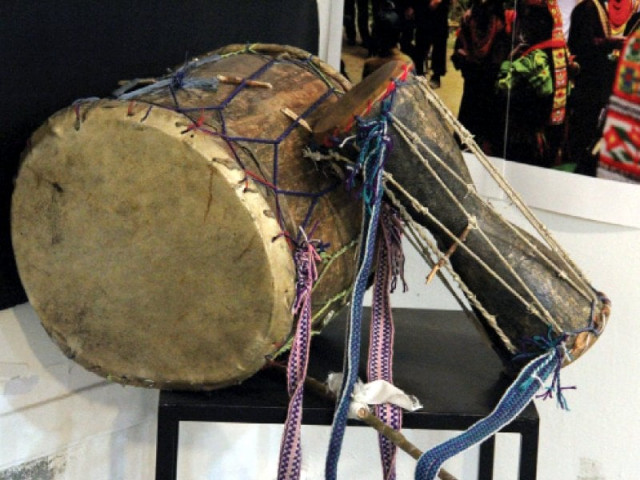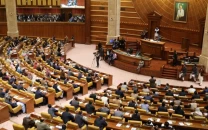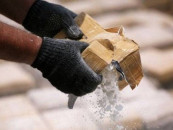Young musician gives a new twist to Waris Shah’s tune
Umer Latif has recorded Heer, traditionally performed in Bhairvin, in five ragas.

Asfar Hussain’s display featured instruments used in traditional Kailasha music. PHOTO: AYESHA MIR/EXPRESS
Latif has composed and performed the timeless classic in Bhairav, Maan, Aimen, Malkons and Bhageshri. He has also performed it in Bhairvin “to provide a point of reference”.
Latif says that Heer has been his muse for as long as he can remember. He says he already knew when he joined the college what his thesis would be. His love for the classic began with the village melas he used to attend as a child. “Initially, my family was not very enthusiastic about my work.”
The melodies Latif has recorded incorporate various instruments including the daf, pianoforte, guitars and drums. He says while presenting it for different audiences, he has tried to stay true to the essence of Heer.
“Now my family proudly shows off my work and I am planning to work with some of the biggest music production houses and names in the industry,” he says.
Asfar Hussain’s project on the traditional music of the Kailasha could be the first step to conserve a culture struggling to survive, Head of Department Sarwat Ali says.
Most of the work done on the Kailasha is anthropological or historic, its music has not been documented or studied, Hussain explains. He has tried to break down the rhythm and melody and provide a technical analysis of the music.
Dance and music are central to the culture of Kailasha, but like their folklore and myths, their music has not been documented. Hussain travelled to Bumburet for the Zhoshi (spring festival) and interviewed the elders of the tribe in order to understand structural patterns and rhythmic categories in the music.
Hussain hails from Chitral and has always been fascinated by the rich culture and traditions of the Kailasha. “I felt it was a travesty that no one ever properly studied their music,” he said.
Hamal Hussain’s work also involves charting structures of an ethnic musical tradition. It centres on an ethno-musicological study of Baloch culture through its principal form of music – Zahirok. He has compared the melodic structure and compositional features of Zahirok with other genres of Baloch music. He has also drawn comparisons with Indian classical music. Zahirok’s Jarh has 10 derivative scales, which Hussain has compared to the 10 thaats of Indian classical music.
“This is my culture. I am strongly rooted in this. It is my duty to promote it,” he says. Hussain plans to take his research forward and do a PhD on Zahirok.
Shehryar Ahmed Khan aka Sherry King’s rap posters are pasted all over the campus. His work blends rap music and raga to “create a new genre” called Rap ‘n Raga. Khan says that his work attempted not to fuse, but to create a new form of music that incorporated both genres. The recordings incorporate Aimen, Puriya, Basant, Darbari, Kamod and Hameer with digital electronic music and hip hop beats.
“Classical music is dying out as a tradition,” he said. “The youth do not listen to classical music any longer. I want to preserve this tradition, which is why I have tried to bring out the best in the two genres.”
Khan says he is looking to launch his music commercially.
Irfan Ahmed’s work attempts to explore the theoretical relationship of vadi and samvadi notes in a raga. He says that dominant musicological theories suggest that vadi – considered the most important note in a raga – rests on the frequency of its occurrence in the performance. However, Indian classical music is historically studied in shruti – not in the Western temporal frame. “It was in the Bhatkhande period that the definitions and concepts of Indian classical music were moulded in the temporal frame,” he explained.
Ahmed’s work involved an empirical analysis of several performances in which he showed that the vadi note, was in fact, not the most frequently occurring one. “There was a yawning gap between theory and practice. I realised that performers just did not follow the rule about the vadi.”
Ahmed says that he has always been fascinated with classical music. “I won a gold medal at the All Pakistan Music Conference when I was in grade seven. It is a shame that classical music is dying out. People nowadays feel ashamed of their culture. I suppose it’s a colonial legacy.”
Sarwat Ali says that the department has tried this year to strike a balance between theory and practice. Khan and Latif’s projects feature recordings supported with theses, whereas, Ahmed, Hamal Hussain and Asfar Hussain’s works are more theoretical.
Published in The Express Tribune, February 20th, 2015.



















COMMENTS
Comments are moderated and generally will be posted if they are on-topic and not abusive.
For more information, please see our Comments FAQ